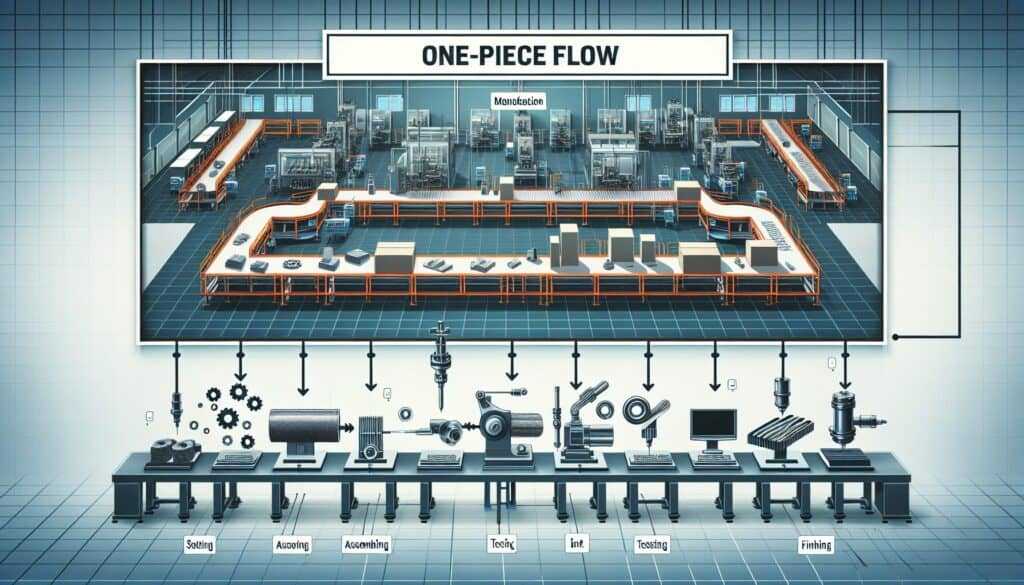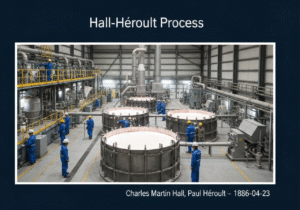To produce and move one item at a time (or a very small batch) between operations, rather than processing in large batches.
- المنهجيات: العملاء والتسويق, الاقتصاد, لين سيجما, تصنيع, إدارة المشاريع, الجودة
One-Piece Flow

One-Piece Flow
- التحسين المستمر, في الوقت المحدد (JIT), التصنيع اللين, الإنتاج المرن, تحسين العمليات, كفاءة الإنتاج, إدارة الجودة, تخطيط مسار القيمة, استراتيجيات التخلص من النفايات
الهدف:
كيفية استخدامه:
- Arranges workstations in sequence, allowing a single unit to pass through all process steps without work-in-process (WIP) accumulation or delays. Closely associated with Just-In-Time and cellular manufacturing.
الايجابيات
- Reduces WIP inventory, lead times, and space requirements; Improves quality by enabling rapid feedback and defect detection; Increases flexibility and responsiveness to customer demand; Simplifies production control.
سلبيات
- Requires stable and reliable processes with high uptime and consistent quality; Can be challenging to balance workloads across all operations; May require significant layout changes and operator cross-training; Less suitable for processes with very long setup times.
الفئات:
- لين سيجما, تصنيع
الأفضل لـ
- Creating a highly efficient, continuous, and responsive production system, especially in environments with a variety of products.
One-Piece Flow is commonly employed in industries such as automotive manufacturing, electronics, and consumer goods, where speed and efficiency are paramount due to high competition and rapid market changes. This methodology is particularly effective during assembly processes and demands a high degree of coordination among teams, prompting cross-functional collaboration between engineers, designers, and production staff to optimize workflow. Initiated by lean practitioners or process improvement teams, it often begins in pilot projects or specific product lines, enabling organizations to assess feasibility before a full-scale rollout. Implementation requires a thorough understanding of product variations and customer demand patterns to effectively operate the flow with minimal disruption. Techniques such as Value Stream Mapping may be utilized to identify bottlenecks and enhance layout design for improved flow, directly influencing cycle times and inventory levels. Industries employing One-Piece Flow benefit from enhanced customer satisfaction due to reduced lead times and improved responsiveness to shifts in demand, making it especially suited for environments where customization is valued. The integration of technology, like real-time data tracking systems, reinforces this methodology by providing visibility into each step of the process, facilitating quicker adjustments to production schedules when necessary. Training and involvement of all stakeholders, including shop floor workers and management, are crucial in sustaining these improvements, creating a culture that supports continuous improvement and innovation throughout the production cycle.
الخطوات الرئيسية لهذه المنهجية
- Design the layout for workstations in a linear sequence based on the product flow.
- Implement standardized work procedures at each workstation to ensure consistency.
- Train operators on multi-tasking to reduce dependency on specific roles.
- Establish pull signals to trigger production based on current demand.
- Monitor workflow continuously to identify and eliminate bottlenecks.
- Integrate quality control checks at each workstation for immediate feedback.
- Encourage cross-functional collaboration to address issues as they arise.
- Utilize visual management tools for real-time tracking of production progress.
- Conduct regular assessments to optimize the flow and adjust processes as necessary.
نصائح للمحترفين
- Conduct regular process mapping sessions to identify and eliminate bottlenecks within the one-piece flow, ensuring optimal alignment of workstations.
- Implement real-time data monitoring to analyze cycle times and adjust workflows dynamically, enhancing responsiveness to demand fluctuations.
- Utilize standardized work instructions across all stations, fostering consistency and enabling rapid training of personnel to maintain flow integrity.
لقراءة عدة منهجيات ومقارنتها, نوصي باستخدام
> مستودع المنهجيات الشامل <
مع أكثر من 400 منهجية أخرى.
نرحب بتعليقاتكم على هذه المنهجية أو المعلومات الإضافية على قسم التعليقات أدناه ↓، وكذلك أي أفكار أو روابط متعلقة بالهندسة.
السياق التاريخي
1890
1924
1930
1940
1950
1950
1958
1886-04-23
1897
1930
1940
1949
1950
1950
1960
(إذا كان التاريخ غير معروف أو غير ذي صلة، على سبيل المثال "ميكانيكا الموائع"، يتم تقديم تقدير تقريبي لظهوره الملحوظ)















منشورات ذات صلة
استبيانات الانزعاج العضلي الهيكلي
الاختبار متعدد المتغيرات (MVT)
تحليل الانحدار المتعدد
أنظمة التقاط الحركة
طريقة MoSCoW
اختبار متوسط المزاج